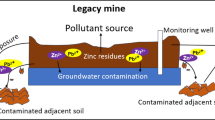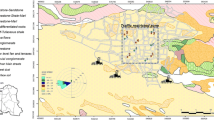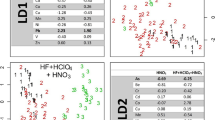Abstract
Historical mining activities in the village of Kaňk (in the northern part of the Kutná Hora ore district, Czech Republic) produced large amounts of mine wastes which contain significant amounts of metal(loid) contaminants such as As, Cu, Pb, and Zn. Given the proximity of residential communities to these mining residues, we investigated samples of mine waste (n = 5), urban soil (n = 6), and road dust (n = 5) with a special focus on the solid speciation of As, Cu, Pb, and Zn using a combination of methods (XRD, SEM/EDS, oxalate extractions), as well as on in vitro bioaccessibility in simulated gastric and lung fluids to assess the potential exposure risks for humans. Bulk chemical analyses indicated that As is the most important contaminant in the mine wastes (~1.15 wt%), urban soils (~2900 mg/kg) and road dusts (~440 mg/kg). Bioaccessible fractions of As were quite low (4–13%) in both the simulated gastric and lung fluids, while the bioaccessibility of metals ranged between <0.01% (Pb) and 68% (Zn). The bioaccessibilities of the metal(loid)s were dependent on the mineralogy and different adsorption properties of the metal(loid)s. Based on our results, a potential health risk, especially for children, was recognized from the ingestion of mine waste materials and highly contaminated urban soil. Based on the risk assessment, arsenic was found to be the element posing the greatest risk.




Similar content being viewed by others
References
ATSDR—Agency for Toxic Substances and Disease Registry (2015) Minimal Risk Levels for Hazardous Substances (MRLs)—March 2016. Retrieved October 26, 2016 from https://www.atsdr.cdc.gov/mrls/pdfs/atsdr_mrls.pdf.
Baron, D., & Palmer, C. D. (1996). Solubility of jarosite at 4–35 °C. Geochimica et Cosmochimica Acta, 60(2), 185–195.
Basta, N. T., & Juhasz, A. (2014). Using in vivo bioavailability and/or in vitro gastrointestinal bioaccessibility testing to adjust human exposure to arsenic from soil ingestion. Reviews in Mineralogy and Geochemistry, 79, 451–472.
Beak, D. G., Basta, N. T., Sheckel, K. G., & Traina, S. J. (2006). Bioaccessibility of arsenic(V) bound to ferrihydrite using a simulated gastrointestinal system. Environmental Science and Technology, 40(4), 1364–1370.
Bílek, J., Hoffman, V., & Trdlička, Z. (1965). Kutnohorské odvaly. In Sborník Oblastního muzea v Kutné Hoře, řada geologicko-báňská (Vol. 7, pp. 1–45).
Bradham, D. K., Scheckel, K. G., Nelson, C. M., Seales, P. E., Lee, G. E., Hughes, M. F., et al. (2011). Relative bioavailability and bioaccessibility and speciation of arsenic in contaminated soils. Environmental Health Perspectives, 119(11), 1629–1634.
Cho, Y. M., Seo, S. C., Choi, S.-H., Lee, S. K., Kim, K. H., Kim, H. J., et al. (2013). Association of arsenic levels in soil and water with urinary arsenic concentration of residents in the vicinity of closed metal mines. International Journal of Hygiene and Environmental Health, 216(3), 255–262.
Davies, N. M., & Feddah, M. R. (2003). A novel method for assessing dissolution of aerosols inhaler products. International Journal of Pharmaceutics, 255(1–2), 175–187.
Davis, A., Drexler, J. W., Ruby, M. V., & Nicholson, A. (1993). Micromineralogy of mine waste in relation to lead bioavailability, Butte, Montana. Environmental Science & Technology, 27(7), 1415–1425.
Davis, A., Ruby, M. V., Bloom, M., Schoof, R., Freeman, G., & Bergstrom, P. D. (1996). Mineralogical constraints on the bioavailability of arsenic in smelter-impacted soils. Environmental Science and Technology, 30(2), 392–399.
Deshommes, E., Tardif, R., Edwards, M., Sauvé, S., & Prévost, M. (2012). Experimental determination of oral bioavailability and bioaccessibility of lead particles. Chemistry Central Journal, 6, 138.
Dold, B. (2003). Dissolution kinetics of schwertmannite and ferrihydrite in oxidized mine samples and their detection by differential X-ray diffraction (DXRD). Applied Geochemistry, 18(10), 1531–1540.
Drahota, P., Grösslová, Z., & Kindlová, H. (2014). Selectivity assessment of an arsenic sequential extraction procedure for evaluating mobility in mine wastes. Analytica Chimica Acta, 839, 34–43.
Ettler, V., Kříbek, B., Majer, V., Knésl, I., & Mihaljevič, M. (2012). Differences in the bioaccessibility of metals/metalloids in soils from mining and smelting areas (Copperbelt, Zambia). Journal of Geochemical Exploration, 113, 68–75.
Ettler, V., Vítková, M., Mihalevič, M., Šebek, O., Klementová, M., Veselovský, F., et al. (2014). Dust from Zambian smelters: mineralogy and contaminant bioaccessibility. Environmental Geochemistry and Health, 36(5), 919–933.
European Council. (1999). Directive 1999/30/EC of the Council of 22 April 1999 relating to sulphur dioxide, nitrogen dioxide and oxides of nitrogen, particulate matter and lead in ambient air. Official Journal of the European Union, L163, 41–60.
European Council. (2005). Directive 2004/107/EC of the European Parliament and of the Council of 15 December 2004 relating to arsenic, cadmium, mercury, nickel and polycyclic aromatic hydrocarbons in ambient air. Official Journal of the European Union, L23, 3–16.
Frau, F., Biddau, R., & Fanfani, L. (2008). Effect of major anions on arsenate desorption from ferrihydrite-bearing natural samples. Applied Geochemistry, 22(6), 1451–1466.
Gamiño-Guitérrez, S. P., González-Pérez, I., Gonsebatt, M. E., & Monroy-Fernández, M. G. (2013). Arsenic and lead contamination in urban soils of Villa de la Paz (Mexico) affected by historical mine wastes and its effect on children’s health studied by micronucleated exfoliated cells assay. Environmental Geochemistry and Health, 35(1), 37–51.
Goh, K.-H., & Lim, T.-T. (2005). Arsenic fractionation in a fine soil fraction and influence of various anions on its mobility in the subsurface environment. Applied Geochemistry, 20(2), 229–239.
Goix, S., Uzu, G., Oliva, P., Barraza, F., Calas, A., Castet, S., et al. (2016). Metal concentration and bioaccessibility in different particle sizes of dust and aerosols to refine metal exposure assessment. Journal of Hazardous Materials, 317, 552–562.
Hindmarsh, J. T., Dekerkhove, K., Grime, G., & Powell, J. (1999). Hair arsenic as an index of toxicity. In E. R. Chappell, C. O. Abernathy, & R. L. Calderon (Eds.), Arsenic exposure and health effects (pp. 41–49). New York: Elsevier.
Horák, J., & Hejcman, M. (2016). 800 Years of mining and smelting in Kutná Hora region (the Czech Republic)—spatial and multivariate meta-analysis of contamination studies. Journal of Soils and Sediments, 16(5), 1584–1598.
Huang, M., Chen, X., Zhao, Y., Chan, C. Y., Wang, W., Wang, X., et al. (2014). Arsenic speciation in total contents and bioaccessible fractions in atmospheric particles related to human intakes. Environmental Pollution, 188, 37–44.
IARC. (2012). A review of human carcinogens: Arsenic, metals, fibres, and dusts. Lyon, France: IARC monographs on the evaluation of carcinogenic risks to humans, vol. 100, World Health Organization.
ICDD. (2003). PDF-2 database, release 2003. Newton Square, PA: International Centre for Diffraction Data.
ISO. (1995). ISO Standard 11466, Soil quality: Extraction of trace elements soluble aqua regia. Geneva: International Organization for Standardization.
JECFA. (1999). Summary and conclusions. 53thd meeting, Rome.
Juhasz, A. L., Herde, P., Herde, C., Boland, J., & Smith, E. (2014a). Validation of the predictive capabilities of the Sbrs-G in vitro assay for estimating arsenic relative bioavailability in contaminated soils. Environmental Science and Technology, 48(21), 12962–12969.
Juhasz, A. L., Smith, E., Nelson, C., Thomas, D. J., & Bradham, K. (2014b). Variability associated with as in vivo-in vitro correlations when using different bioaccessibility methodologies. Environmental Science and Technology, 48(19), 11646–11653.
Juhasz, A. L., Smith, E., Weber, J., Rees, M., Rofe, A., Kuchel, T., et al. (2007). In vitro assessment of arsenic bioaccessibility in contaminated (anthropogenic and geogenic) soils. Chemosphere, 69(1), 69–78.
Karadaş, C., & Kara, D. (2011). In vitro gastro-intestinal method for assessment of heavy metal bioavailability in contaminated soils. Environmental Science and Pollution Research, 18(4), 620–628.
Kelley, M. E., Brauning, S. E., Schoof, R. A., & Ruby, M. V. (2002). Assessing oral bioavailability of metals in soil. Columbus, OH: Battelle Press.
Kim, E. J., Yoo, J. C., & Baek, K. (2014). Arsenic speciation and bioaccessibility in arsenic-contaminated soils: Sequential extraction and mineralogical investigation. Environmental Pollution, 186, 29–35.
Kocourková-Víšková, E., Loun, J., Sracek, O., Houzar, S., & Filip, J. (2015). Secondary arsenic minerals and arsenic mobility in a historical waste rock piles at Kaňk near Kutná Hora, Czech Republic. Mineralogy and Petrology, 109(1), 17–33.
Kořan, J. (1950). Dějiny dolování v rudním okrsku kutnohorském. Praha, CR: Vědecko-technické nakladatelství, Geotechnica, svazek 11.
Liu, Y., Ma, J., Yan, H., Ren, Y., Wang, B., Lin, C., et al. (2016). Bioaccessibility and health risk assessment of arsenic in soil and indoor dust in rural and urban areas of Hubei province, China. Ecotoxicology and Environmental Safety, 126, 14–22.
Majzlan, J., Drahota, P., Filippi, M., Grevel, K.-D., Kahl, W.-A., Plášil, J., et al. (2012). Thermodynamic properties of scorodite and parascorodite (FeAsO4·2H2O), kaňkite (FeAsO4·3.5H2O), and FeAsO4. Hydrometallurgy, 117–118, 47–56.
Metodický pokyn MŽP. (1996). Kritéria pro znečištění zemin, podzemní vody a půdního vzduchu. Technical report, Ministerstvo životního prostředí České republiky, Praha.
Meunier, L., Walker, S. R., Wragg, J., Parsons, M. B., Koch, I., Jamieson, H. E., et al. (2010). Effect of soil composition and mineralogy on the bioaccessibility of arsenic from tailings and soil in gold mine district of Nova Scotia. Environmental Science and Technology, 44(7), 2667–2674.
Mikutta, C., Mandaliev, P. N., Mahler, N., Kotsev, T., & Kretzschmar, R. (2014). Bioaccessibility of arsenic in mining-impacted circumneutral river floodplain soils. Environmental Science and Technology, 48(22), 13468–13477.
Moss, O. R. (1979). Simulants of lung interstitial fluid. Health Physics, 36(3), 447–448.
Ollson, C. J., Smith, E., Scheckel, K. G., Betts, A. R., & Juhasz, A. L. (2016). Assessment of arsenic speciation and bioaccessibility in mine-impacted materials. Journal of Hazardous Materials, 313, 130–137.
Paktunc, D., Majzlan, J., Huang, A., Thibault, Y., Johnson, M. B., & White, M. A. (2015). Synthesis, characterization, and thermodynamics of arsenates forming in the Ca–Fe(III)–As(V)–NO3 system: Implications for the stability of Ca–Fe arsenates. American Mineralogist, 100(8–9), 1803–1820.
Palumbo-Roe, B., Wragg, J., & Cave, M. (2015). Linking selective chemical extraction of iron oxyhydroxides to arsenic bioaccessibility in soil. Environmental Pollution, 207, 256–265.
Pauliš, P. (1998). Minerály kutnohorského rudního revíru. Kutná Hora, CR: Kuttna Press.
Reis, A. P., Patinha, C., Noack, Y., Robert, S., Dias, A. C., & Ferreira da Silva, E. (2014). Assessing the human health risk for aluminium, zinc, and lead in outdoor dusts collected in recreational sites used by children at an industrial area in the western part of the Bassin Minier de Provence, France. Journal of African Earth Sciences, 99(2), 724–734.
Ruby, M. V., Schoof, R., Brattin, W., Goldade, M., Post, G., Harnois, M., et al. (1999). Advances in evaluating the oral bioavailability of inorganics in soil for use in human health risk assessment. Environmental Science and Technology, 33(21), 3697–3705.
Rychlíková, E., Šubrt, D., Suchomelová, I., Hrubcová, I., Hrdličková, E., Moravcová, J., et al. (2015). Dílčí hodnocení zdravotního rizika obyvatel locality Kutná Hora—Kaňk. Technical report, Zdravotní ústav se sídlem v Ústí nad Labem, Ústí nad Labem.
Sáňka, M., Čupr, P., Kadlubiec, R., Malec, J., Skybová, M. & Škarek, M. (2003). Riziková analýza a monitorování složek životního prostředí v Kutné Hoře a okolí. Technical report, Ekotoxa Opava, s.r.o., Opava.
Smith, A. M. L., Dubbin, W. E., Wright, K., & Hudson-Edwards, K. A. (2006). Dissolution of lead- and lead-arsenic-jarosites at pH 2 and 8 and 20 °C: Insights from batch experiments. Chemical Geology, 229(4), 344–361.
Spěváčková, V., Čejchmanová, M., Černá, M., Spěváček, V., Šmíd, J., & Beneš, B. (2002). Population-based biomonitoring in the Czech Republic: Urinary arsenic. Journal of Environmental Monitoring, 4(5), 796–798.
Twining, J., McGlinn, P., Loi, E., Smith, K., & Gieré, R. (2005). Risk ranking of bioaccessible metals from fly ash dissolved in simulated lung and gut fluids. Environmental Science and Technology, 39(19), 7749–7756.
US EPA. (2004). Risk assessment guidance for superfund volume I: Human health evaluation manual. Washington, DC: Office of Emergency and Remediation Response. EPA/540/R/99/005.
US EPA. (2011). Exposure factors handbook (EFH). Washington, DC: National Center for Environmental Assessment, US EPA. EPA/600/R-09/052F.
Vyhláška č. 432. (2003). Podmínky pro zařazování prací do kategorií, limitní hodnoty ukazatelů biologických expozičních testů, podmínky odběru biologického materiálu pro provádění biologických expozičních testů a náležitosti hlášení prací s azbestem a biologickými činiteli. Technical report, Ministerstvo životního prostředí České republiky, Praha.
Webster, J. G., Swedlund, P. J., & Webster, K. S. (1998). Trace metal adsorption onto an acid mine drainage iron(III) oxy hydroxy sulfate. Environmental Science and Technology, 32(10), 1361–1368.
Wenzel, W. W., Kirchbaumer, N., Prohaska, T., Stingeder, G., Lombi, E., & Adriano, D. C. (2001). Arsenic fractionation in soils using an improved sequential extraction procedure. Analytica Chimica Acta, 436(2), 309–323.
Wiseman, C. L. S. (2015). Analytical methods for assessing metal bioaccessibility in airborne particulate matter: A scoping review. Analytica Chimica Acta, 877, 9–18.
Wiseman, C. L. S., & Zereini, F. (2014). Characterizing metal(loid) solubility in airborne PM10, PM2.5 and PM1 in Frankfurt, Germany using simulated lung fluids. Atmospheric Environment, 89, 282–289.
Zheng, N., Liu, J., Wang, Q., & Liang, Z. (2010). Health risk assessment of heavy metal exposure to street dust in the zinc smelting district, Northeast of China. Science of the Total Environment, 408(4), 726–733.
Acknowledgements
This work was funded by the Czech Science Foundation (GAČR) Grant 16-09352S. The corresponding author’s team was also supported by the Operational Programme Prague - Competitiveness (Project No. CZ.2.16/3.1.00/21516). Laboratory assistance was provided by Lenka Jílková, Věra Vonásková (digestions), and Noemi Meszárosová (SEM/EDS). Peter Lemkin is thanked for reviewing the English.
Author information
Authors and Affiliations
Corresponding author
Ethics declarations
Conflict of interest
The authors declare that they have no conflicts of interests.
Electronic supplementary material
Below is the link to the electronic supplementary material.
Rights and permissions
About this article
Cite this article
Drahota, P., Raus, K., Rychlíková, E. et al. Bioaccessibility of As, Cu, Pb, and Zn in mine waste, urban soil, and road dust in the historical mining village of Kaňk, Czech Republic. Environ Geochem Health 40, 1495–1512 (2018). https://doi.org/10.1007/s10653-017-9999-1
Received:
Accepted:
Published:
Issue Date:
DOI: https://doi.org/10.1007/s10653-017-9999-1




